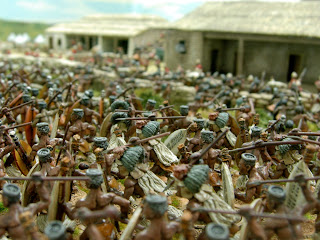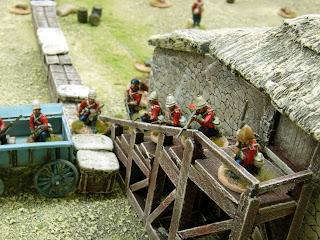Before I start part 4 of The Battle of Rorke's Drift, I would like to make an announcement and give anyone who may be interested the heads-up, that I am going to put my Zulu War collection up FOR SALE.
This will include all the figures, wagons, buildings, pieces of terrain, back-drops and anything else that has been shown on this blog over the past 12 months concerning the Zulu War. I want to sell it, if possible as a complete collection rather than in lots of small parts. So next week I will list a complete breakdown of what there is and the price, along with a sneak peek of the Zulu War British Lancers that I will put on in a future post. Part 5 of Rorke's Drift will have to miss a week and follow on the week after.
THE FIGHT FOR THE HOSPITAL.
As it grew dark, the defenders - six able-bodied men and perhaps 20 armed patients - had a good field of fire from behind windows and loop-holes, but the Zulus came on in such numbers that they were at last able to get close enough to run right up to the outside walls. They broke in first through a door in the wall on the Western end of the building, where Private Joseph Williams, succeeded in shooting 14 of them before he was overcome.
At the front too, once the dog-leg barricade had been abandoned, there was nothing stopping the Zulus rushing the veranda, and forcing their way in through the doors at the front.
Such were the conditions, however, that most of the defenders were unaware of what was happening outside their own rooms. No sooner had the Zulus reached the building than they set the roof on fire.
"Come back Mr Bromhead, Sir"
When Private Hook's room became too full of smoke for him to bear, he rushed through into the next room containing several patients. The Zulus were trying to break through the door he had shut behind him. The interior walls were just made of sun dried mud-brick, and the defenders were able to hack a big hole through the wall and the patients were pushed and pulled through one by one, until at last the man defending the room sprinted after them. Then the whole process began anew in the next room.
They worked their way through to the rooms at the Eastern end of the building. The only way out of the building was now through a small window which opened into the centre of the yard. But the yard had been abandoned, and was effectively no-man's land.
The defenders had to pass the patients out into the darkness, where they dropped to the ground and had to scramble the best they could across the yard towards the sanctuary of the biscuit-box wall opposite.
Private Hook has a last sip of medicine before leaving the building.
THE FIGHTING AROUND THE STOREHOUSE.
Evan as the desperate struggle in the hospital was underway, the Zulus kept up their pressure on the storehouse. Although a number of attacks had been repulsed, it soon became clear that the angle between the front wall and the line of biscuit-boxes was now the most vulnerable sector of the perimeter. This area was the least sheltered from the fire directed on the post from all directions. Furthermore, the Zulus could creep up under cover of the rocky ledge and crouch below it with impunity. Bromhead himself took command of this sector, but the fire was so dangerous that of six men with him only he and one other escaped injury.
Corporal Schiess, an NCO of the NNC who had been wounded in the foot was determined to clear the Zulus away from the ledge, and leaving the shelter of the biscuit-box wall, he crept out a few yards along the abandoned front barricade, suddenly stood up, and leaned across to fire down on the Zulus crouching on the other side. Apart from having his hat shot off, he killed three Zulus before returning to his place.
Pressure on the wall remained intense. Private Hitch wounded in the shoulder and being treated by Surgeon Reynolds, whilst Bromhead defends the wall.
Next week............Zulu War collection FOR SALE.
Week after............The Redoubt and Darkness, the final part of the defence of Rorke's Drift.


































































